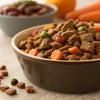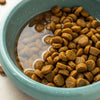How Much Dry Dog Food Should I Feed My Dog? A Comprehensive Guide
- Houndsy
Table of Contents
- Introduction
- Understanding Your Dog's Nutritional Needs
- Calculating the Right Food Portion
- Types of Dog Food and Feeding Strategies
- Monitoring Your Dog's Health and Weight
- Conclusion
Introduction
Did you know that nearly 59% of dogs in the United States are classified as overweight or obese? This alarming statistic underscores the importance of understanding how much dry dog food should be fed to our furry companions. As responsible pet owners, we want to ensure our dogs receive the right amount of nutrition without the risk of overfeeding or underfeeding.
Feeding your dog isn’t just about filling their bowl; it’s a vital aspect of their overall health and well-being. The right amount of food can prevent obesity, nutritional deficiencies, and a host of health complications. This blog post aims to guide you through the various factors that influence how much dry dog food your dog should eat, providing insights that will help you make informed decisions about your pet's diet.
By the end of this article, you’ll have a clearer understanding of how to assess your dog's nutritional needs, the importance of portion control, and how to tailor feeding schedules to suit different life stages. So, let’s dive in and explore the world of dog feeding!
Understanding Your Dog's Nutritional Needs
Age Matters
The age of your dog is one of the most critical factors in determining how much food they should consume. Puppies, adult dogs, and senior dogs all have different nutritional needs:
- Puppies require more calories and specific nutrients to support their rapid growth and development. They typically need food that's rich in protein and fat, and it's crucial to feed them several times a day to maintain their energy levels.
- Adult dogs usually have a stable caloric requirement, but their needs can still vary based on their activity levels. Generally, adult dogs should be fed twice a day, dividing their total daily food intake into two meals.
- Senior dogs often require fewer calories as their metabolism slows. They may also benefit from diets that include ingredients to support joint health and cognitive function.
Size and Breed
The size and breed of your dog significantly impact their dietary needs. Larger breeds typically need more food than smaller breeds, but they also have different metabolic rates. For example:
- Small breeds (like Chihuahuas) may need a higher caloric intake per pound due to their fast metabolism, often requiring smaller, more frequent meals.
- Large breeds (like Great Danes) need a diet that supports their size and joint health, as they are prone to specific issues related to their weight.
Activity Level
A dog's activity level plays a pivotal role in their caloric needs. Active dogs that engage in regular exercise require more energy, while sedentary dogs may need less. For example:
- Working dogs or those who accompany you on outdoor adventures will need a higher calorie intake.
- On the other hand, dogs that lead a more relaxed lifestyle may be at risk for weight gain and should have their portions controlled.
Reproductive Status
If your dog is spayed or neutered, their caloric needs might change. Spayed and neutered dogs often have a lower metabolism, which means they may require fewer calories than intact dogs. Additionally, pregnant or nursing dogs have increased nutritional requirements to support the health of their puppies.
Current Body Condition
Assessing your dog's body condition score (BCS) is essential in determining how much food they should be fed. A dog that is overweight will need fewer calories, while one that is underweight may require more. Regular vet check-ups can help you establish a healthy weight for your dog and adjust their food intake accordingly.
Calculating the Right Food Portion
Using Feeding Guidelines
Most dog food brands provide feeding guidelines on the packaging, often based on the dog's weight and age. These guidelines serve as a starting point, but keep in mind that every dog is unique. Here’s a general guideline based on weight:
- Dogs weighing 3-6 lbs: ⅓ to ½ cup per day
- Dogs weighing 10-20 lbs: ¾ to 1 ⅓ cups per day
- Dogs weighing 30-50 lbs: 1 ¾ to 2 ⅔ cups per day
- Dogs weighing 60-100 lbs: 3 to 4 ½ cups per day
- Dogs over 100 lbs: 4 ½ cups plus ¼ cup for every additional 10 lbs
These recommendations are based on standard dry dog food. Always refer to the specific feeding chart provided by the dog food manufacturer.
Considering Caloric Needs
A helpful method to determine your dog’s calorie needs is to calculate their Resting Energy Requirement (RER). The formula is as follows:
[ \text{RER} = 70 \times (\text{Weight in kg})^{0.75} ]
For example, a 10-kg dog (around 22 lbs) would need approximately 400 calories per day. Adjust this number based on activity level or specific health requirements.
Adjusting Portions
Once you establish a baseline, monitor your dog’s weight and health regularly. If your dog is gaining weight, reduce their portions slightly. Conversely, if they’re losing weight or seem lethargic, consider increasing their food intake.
Types of Dog Food and Feeding Strategies
Dry vs. Wet Food
Choosing between dry and wet dog food can affect how much you feed your dog. Dry food is often more calorie-dense, meaning smaller portions are required. Wet food can provide more moisture but may need larger serving sizes.
- Dry Food: Generally more cost-effective and convenient.
- Wet Food: Often more palatable for picky eaters and can help increase water intake.
Incorporating Treats
Treats can play a role in your dog's diet but should not exceed 10% of their daily caloric intake. For instance, if your dog consumes 400 calories a day, treats should only account for 40 calories. Always choose high-quality treats that offer nutritional value.
Meal Timing and Frequency
Most dogs thrive on a routine. While twice-daily feedings are common for adults, puppies may benefit from three or four smaller meals to support their energy needs. Establishing a consistent feeding schedule not only aids digestion but can also prevent anxiety around meal times.
Monitoring Your Dog's Health and Weight
Signs of Proper Nutrition
A well-nourished dog will typically have:
- A shiny coat
- Clear eyes
- Healthy skin
- Good energy levels
- Firm, easy-to-pick-up stools
Recognizing Overfeeding and Underfeeding
Keep an eye out for signs of overfeeding, such as excessive weight gain, lethargy, or difficulty exercising. Conversely, if your dog is losing weight, seems constantly hungry, or lacks energy, they may not be getting enough food.
Regular Check-Ups
Maintain regular veterinary appointments to monitor your dog’s weight and overall health. Your vet can provide tailored advice on diet adjustments based on your dog’s individual needs.
Conclusion
Feeding your dog the proper amount of dry dog food involves understanding their unique nutritional needs based on age, size, activity level, and health status. By utilizing feeding guidelines, monitoring your dog's body condition, and adjusting portions accordingly, you can ensure that your furry friend stays healthy and happy.
Remember to consult with your veterinarian regularly to fine-tune your dog’s diet and adapt to any changes in their health or lifestyle. If you're looking for a way to simplify your feeding routine, consider exploring the Houndsy Kibble Dispenser. Our innovative design allows for perfect portion control and ergonomic convenience, enhancing the daily feeding experience.
FAQ
How often should I feed my dog?
Most adult dogs should be fed twice a day, while puppies may require three to four meals a day. It's essential to establish a routine that suits your dog’s needs.
Can I free-feed my dog?
Free-feeding can lead to obesity, as not all dogs self-regulate their food intake. It's generally better to stick to scheduled meal times.
What if my dog is overweight?
Consult your veterinarian to create a weight management plan. This may involve adjusting portion sizes, switching to a lower-calorie diet, or increasing exercise.
How do I know if I’m feeding my dog the right amount?
Regularly assess your dog’s weight and body condition. Your vet can help determine if your dog is at a healthy weight and suggest necessary adjustments.
Can I mix wet and dry food?
Yes, mixing wet and dry food can provide a balanced diet and help entice picky eaters. Just be mindful of the caloric content of both types to avoid overfeeding.
Feeding our dogs is a significant responsibility, and by understanding their unique needs, we can ensure they lead long, healthy lives. Let us embrace this journey together, making informed choices that enhance our pets' well-being!












